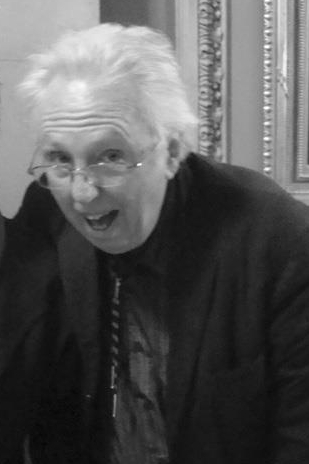Born: January 20, 1944
Age: 81
Birthplace: Brooklyn, New York, U.S.



William Henry Jackson Griffith (born January 20, 1944) is a prolific American cartoonist who signs his work Bill Griffith and Griffy. He is best known for his daily comic strip Zippy. The popular catchphrase "Are we having fun yet?" is credited to Griffith in Bartlett's Familiar Quotations (16th edition, 1992).
Born in Brooklyn, New York, Griffith grew up in Levittown, Long Island, where one of his neighbors was science fiction illustrator Ed Emshwiller, whom he credits with pointing him towards the world of art. Griffith began his comics career in New York City in 1969. He was a prominent cartoonist in the underground comics movement based out of San Francisco in the late 1960s, and co-founded the comics anthology Arcade, the Comics Revue with Art Spiegelman. His first comic strips in the East Village Other and Screw featured an angry amphibian named Mr. The Toad.
He ventured to San Francisco in 1970 to join the burgeoning underground comix movement. His first major comic book titles included Tales of Toad and Young Lust (co-created with cartoonist Jay Kinney), a bestselling series parodying romance comics of the time. He co-edited Arcade for its seven-issue run in the mid-1970s and worked with the leading underground publishers throughout that decade and up to the present: Print Mint, Last Gasp, Rip Off Press, Kitchen Sink and Fantagraphics Books. He contributed comics and illustrations to a variety of publications, including National Lampoon, High Times, The New Yorker, The Village Voice and The New York Times.
In 1998, Griffith moved from San Francisco to Connecticut. His studio is in East Haddam, Connecticut, where he lives with his wife, the cartoonist Diane Noomin.
The first Zippy strip appeared in the underground Real Pulp #1 (Print Mint) in 1971. The strip went weekly in 1976, first in the Berkeley Barb and then syndicated nationally through Rip Off Press. The one-row format Zippy strip debuted in the Berkeley Barb in 1976 and continues in weekly newspapers to this day.
In 1979, he added his alter ego character, Griffy, to the strip. He describes Griffy as "neurotic, self-righteous and opinionated, someone with whom Zippy would certainly contrast. I brought the two characters together around 1979, perhaps symbolically bringing together the two halves of my personality. It worked. Their relationship seemed to make Zippy's random nuttiness more directed and Griffy's cranky, critical persona had his foil, someone to bounce happily off of his constant analysis of everything and everyone around him."
In 1982, the "Zippy Theme Song" was composed and performed, with lyrics by The B-52s' Fred Schneider and vocals by Manhattan Transfer's Janis Siegel. Also on the cut are singers Phoebe Snow and Jon Hendricks.
The daily Zippy strip (syndicated by King Features to over 200 newspapers worldwide) started in 1986. Griffith compares the creation of the strip to jazz: "When I'm doing a Zippy strip, I'm aware that I'm weaving elements together, almost improvising, as if I were all the instruments in a little jazz combo, then stepping back constantly to edit and fine-tune. Playing with language is what delights Zippy the most."
Years ago, as continuity strips gave way to humor strips, typeset episode subtitles vanished from strips. In a nod toward the classic daily strips of yesteryear, Griffith keeps the tradition alive by always centering a hand-lettered subtitle above each Zippy strip.
In 2007, Griffith began to focus his daily strip on Zippy's "birthplace", Dingburg. Griffith said, "Over the years, I began to expand Zippy's circle of friends beyond my usual cast of characters to a wider world of people like Zippy—other pinheads. I kept this up for a few months, happily adding more and more muu-muu-clad men and women until one day the whole thing just reached critical mass. The thought then occurred, 'Where do all these friends of Zippy live? Do they live in the real world which Zippy has been seen escaping for years—or do they live apart, in a pinhead world of their own?' Thus Dingburg, 'The City Inhabited Entirely by Pinheads' was born. It even had a motto: 'Going too far is half the pleasure of not getting anywhere'. The logical next step was to imagine Dingburg streets and neighborhoods—to create a place where Zippy's wacky rules would be the norm and everyone would play 24-hour Skeeball and worship at the feet of the giant Muffler Man. Zippy had, at last, found his home town."
in 2008, Griffith presented a talk on Zippy at the University of Michigan at Ann Arbor. In it, he laid out his "Top 40 List on Comics and their Creation", which since then has been reposted on numerous comics websites.
For a short period, Griffith joined the team of artists, including Kim Deitch, Drew Friedman, Jay Lynch, Norman Saunders, Art Spiegelman, Bhob Stewart and Tom Sutton, who designed Wacky Packages trading cards for the Topps Company. Griffith recently drew Wacky Packages Old School Sketch Cards for Topps.
Zippy books and comics are currently published by Fantagraphics Books. Zippy books include: Zippy Stories, Nation of Pinheads, Pointed Behavior, Pindemonium, Are We Having Fun Yet?, Kingpin, Pinhead's Progress, Get Me a Table Without Flies, Harry (travel sketches), From A to Zippy, Zippy's House of Fun, Griffith Observatory (comic book), Zippy Annual #1, Zippy Annual 2001, Zippy Annual 2002, Zippy Annual 2003, Zippy: From Here to Absurdity, Zippy: Type Z Personality, Zippy: Connect the Polka Dots, Zippy: Walk a Mile in My Muu-Muu, Zippy: Welcome to Dingburg and Zippy: Ding Dong Daddy from Dingburg.
In January 2012, Fantagraphics published "Bill Griffith: Lost and Found, Comics 1969-2003", a 392-page collection of Griffith's early work in underground comics from the East Village Other to his pages for The New Yorker and the National Lampoon in the 1980s and 1990s.
[ Source: Wikipedia ]